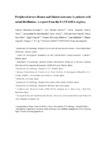Mostrar o rexistro simple do ítem
Peripheral artery disease and clinical outcomes in patients with atrial fibrillation: A report from the FANTASIIA registry
| dc.contributor.author | Bertomeu-González, Vicente | |
| dc.contributor.author | Moreno-Arribas, José | |
| dc.contributor.author | Esteve-Pastor, María Asunción | |
| dc.contributor.author | Roldán-Rabadán, Inmaculada | |
| dc.contributor.author | Muñiz, Javier | |
| dc.contributor.author | Otero García, Deborah | |
| dc.contributor.author | Ruiz-Ortiz, Martín | |
| dc.contributor.author | Cequier, Ángel | |
| dc.contributor.author | Bertomeu-Martínez, Vicente | |
| dc.contributor.author | Badimón, Lina | |
| dc.contributor.author | Anguita, Manuel | |
| dc.contributor.author | Lip, Gregory Y.H. | |
| dc.contributor.author | Marín, Francisco | |
| dc.date.accessioned | 2022-04-06T10:57:23Z | |
| dc.date.available | 2022-04-06T10:57:23Z | |
| dc.date.issued | 2020-10-16 | |
| dc.identifier.citation | Bertomeu-Gonzalez V, Moreno-Arribas J, Esteve-Pastor MA, Roldán-Rabadán I, Muñiz J, Otero García D, Ruiz-Ortiz M, Cequier Á, Bertomeu-Martínez V, Badimón L, Anguita M, Lip GYH, Marín F; FANTASIIA Study Investigators. Peripheral artery disease and clinical outcomes in patients with atrial fibrillation: A report from the FANTASIIA registry. Eur J Clin Invest. 2021 Apr;51(4):e13431. | es_ES |
| dc.identifier.issn | 0014-2972 | |
| dc.identifier.uri | http://hdl.handle.net/2183/30406 | |
| dc.description | Observational study | es_ES |
| dc.description.abstract | [Abstract] Background: Atrial fibrillation (AF) and peripheral artery disease (PAD) are common conditions that increase cardiovascular risk. We determined the association between PAD and prognosis in a cohort of real-world patients receiving oral anticoagulant therapy for nonvalvular AF. Methods: We prospectively included 1956 patients (mean age 73.8 ± 9.5 years, 44.0% women) receiving oral anticoagulant therapy for AF. Clinical characteristics were collected at baseline. Patients were followed for a period of 3 years. Survival analysis and multivariable regression analyses were performed to assess variables related to death, stroke, bleeding, myocardial infarction and major adverse cardiovascular events (MACE). Results: Patients with PAD (n = 118; 6%) exhibited higher rates of cardiovascular risk factors and cardiovascular diseases. After 3 years of follow-up, there were a total of 255 deaths (no PAD 233, vs PAD 22), 45 strokes (43 vs 2), 146 major bleedings (136 vs 10) and 168 MACE (148 vs 20). On univariate analysis, there was a higher risk of cardiovascular mortality (2.02%/year no PAD vs 4.08%/year PAD, P = .02), myocardial infarction (0.99%/year no PAD vs 2.43%/year PAD, P = .02) and MACE (3.18%/year no PAD vs 6.99%/year PAD, P < .01). There was no statistically significant association with these events after multivariable adjustment. Conclusions: In a large cohort of anticoagulated patients with AF, the presence of PAD represents a higher risk subgroup and is associated with worse crude outcomes. The exact contribution of the PAD independently of other cardiovascular diseases or risk factors requires further investigation. | es_ES |
| dc.description.sponsorship | The FANTASIIA registry was funded by an unconditional grant from Pfizer/Bristol-Myers-Squibb and by grants from the Instituto de Salud Carlos III (Madrid)-FEDER (RD16/11/00420, RD12/0042/0068, RD12/0042/0010, RD12/0042/0069, and RD12/0042/0063). The authors are supported by RD12/0042/0049 (RETICS) from ISCIII and PI13/00513/FEDER from ISCIII. Fundación Séneca (19245/PI/14), Instituto Murciano de Investigación Biosanitaria (IMIB16/AP/01/06). | es_ES |
| dc.description.sponsorship | Instituto de Salud Carlos III; RD16/11/00420 | es_ES |
| dc.description.sponsorship | info:eu-repo/grantAgreement/MINECO/Acción Estratégica de Salud/RD12%2F0042%2F0068/ES/Enfermedades cardiovasculares | es_ES |
| dc.description.sponsorship | info:eu-repo/grantAgreement/MINECO/Acción Estratégica de Salud/RD12%2F0042%2F0010/ES/Enfermedades cardiovasculares | es_ES |
| dc.description.sponsorship | info:eu-repo/grantAgreement/MINECO/Acción Estratégica de Salud/RD12%2F0042%2F0069/ES/Enfermedades cardiovasculares | es_ES |
| dc.description.sponsorship | info:eu-repo/grantAgreement/MINECO/Acción Estratégica de Salud/RD12%2F0042%2F0063/ES/Enfermedades cardiovasculares | |
| dc.description.sponsorship | info:eu-repo/grantAgreement/MINECO/Acción Estratégica de Salud/RD12%2F0042%2F0049/ES/Enfermedades cardiovasculares | |
| dc.description.sponsorship | info:eu-repo/grantAgreement/MINECO/Programa Estatal de I+D+I Orientada a los Retos de la Sociedad/PI13%2F00513/ES/NUEVOS ANTICOAGULANTES ORALES EN LA FIBRILACIÓN AURICULAR | |
| dc.language.iso | eng | es_ES |
| dc.publisher | Wiley | es_ES |
| dc.relation.uri | https://doi.org/10.1111/eci.13431 | es_ES |
| dc.rights | This is the peer reviewed version of the article which has been published in final form at Wiley Online Library. This article may be used for non-commercial purposes in accordance with Wiley Terms and Conditions for Use of Self-Archived Versions. This article may not be enhanced, enriched or otherwise transformed into a derivative work, without express permission from Wiley or by statutory rights under applicable legislation. Copyright notices must not be removed, obscured or modified. The article must be linked to Wiley’s version of record on Wiley Online Library and any embedding, framing or otherwise making available the article or pages thereof by third parties from platforms, services and websites other than Wiley Online Library must be prohibited | es_ES |
| dc.subject | Atrial fibrillation | es_ES |
| dc.subject | Mortality | es_ES |
| dc.subject | Peripheral artery disease | es_ES |
| dc.subject | Prognosis | es_ES |
| dc.subject | Stroke | es_ES |
| dc.title | Peripheral artery disease and clinical outcomes in patients with atrial fibrillation: A report from the FANTASIIA registry | es_ES |
| dc.type | info:eu-repo/semantics/article | es_ES |
| dc.rights.access | info:eu-repo/semantics/openAccess | es_ES |
| UDC.journalTitle | European Journal of Clinical Investigation | es_ES |
| UDC.volume | 51 | es_ES |
| UDC.issue | 4 | es_ES |
| UDC.startPage | e13431 | es_ES |






